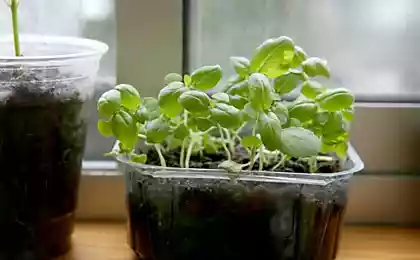195
How to keep basil leaves fresh until the New Year
I'm pretty conservative in the kitchen. I don’t like to over-experiment and spoil products in the course of my inventions. But sometimes something comes to me, the usual routine seems incredibly boring and boring. Then new products come into play. I especially like to try various seasonings, spices and herbs. They do not change the essence of the dish, but can give it a unique shade. This year, my “victim” was basil. I really liked it, but the season is over. I'm looking. Ways to store basil To enjoy it all year round...
Having decided to use a new ingredient, I try to learn everything about it. Not only how it is stored, but also its history and origin. You won’t believe how much you can learn by reading a description of a plant. For example, you knew that basil is also known as reichon, reigan and royal grass. This royal herb was considered a holy plant in India. It was believed to ward off evil spirits and scorpions.

If you have never seen basil grow, know that it has a four-sided branched stem that can reach almost a meter, and many leaves. This plant blooms with small white-pink and purple flowers. Usually in our markets you can find opal basil, but in Europe more common lemon and green.

Storage and use of Basil is wonderfully complementary to cheese and tomato dishes. You can dance from these ingredients anywhere. For example, you can prepare a paste or make a fragrant filling for lavash based on cottage cheese. Also, basil will serve as an excellent seasoning for eggplant in Italian.

But the storage of the basilica for me is still a mystery. Especially its long-term version. In preparation for the winter, I interviewed many friends who also like to use this plant as a seasoning. Here are the storage options I learned:

Storage options for basilica

I have never tried any of these methods in practice and am very afraid to spoil the product. Have you tried any of them and can recommend the most reliable?
Having decided to use a new ingredient, I try to learn everything about it. Not only how it is stored, but also its history and origin. You won’t believe how much you can learn by reading a description of a plant. For example, you knew that basil is also known as reichon, reigan and royal grass. This royal herb was considered a holy plant in India. It was believed to ward off evil spirits and scorpions.

If you have never seen basil grow, know that it has a four-sided branched stem that can reach almost a meter, and many leaves. This plant blooms with small white-pink and purple flowers. Usually in our markets you can find opal basil, but in Europe more common lemon and green.

Storage and use of Basil is wonderfully complementary to cheese and tomato dishes. You can dance from these ingredients anywhere. For example, you can prepare a paste or make a fragrant filling for lavash based on cottage cheese. Also, basil will serve as an excellent seasoning for eggplant in Italian.

But the storage of the basilica for me is still a mystery. Especially its long-term version. In preparation for the winter, I interviewed many friends who also like to use this plant as a seasoning. Here are the storage options I learned:

Storage options for basilica
- grind in blender and freeze in ice mold
- transplant from the garden to the pot (an unexpected bonus is a pleasant aroma throughout the apartment)
- Just dry (it turns out much better than dried shop)
- finely cut, put in cans and pour oil (you have to spend money on oil, but then it can be used for various purposes)

- plant
- grind, add olive oil and garlic
- grind
- wash, dry on a towel, separate the leaves and stick in sealed bags on the fasteners, release air through a tube
- make pesto sauce and freeze

I have never tried any of these methods in practice and am very afraid to spoil the product. Have you tried any of them and can recommend the most reliable?
What awaits a fashionista in Europe if she notices a fake “Louis Vuitton”
What Happens When You Marry Your Mother's Son?
























